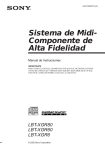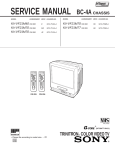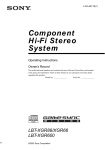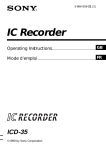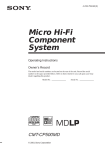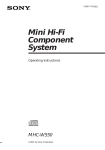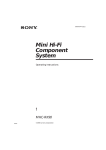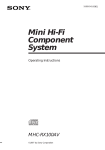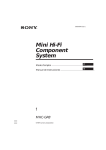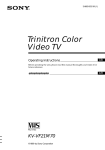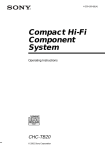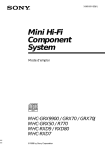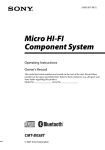Download Sony LBT-XGR80 User's Manual
Transcript
4-238-809-11 (4) Compact Hi-Fi Stereo System Operating Instructions Owner’s Record The model and serial numbers are located on the rear panel of the unit. Record the serial number in the space provided below. Refer to them whenever you call upon your Sony dealer regarding this product. Model No. LBT-XGR80 LBT-XGR60 LBT-XGR6 © 2002 Sony Corporation Serial No. CAUTION WARNING To prevent fire or shock hazard, do not expose the unit to rain or moisture. To avoid electrical shock, do not open the cabinet. Refer servicing to qualified personnel only. Do not install the appliance in a confined space, such as a bookcase or built-in cabinet. This appliance is classified as a CLASS 1 LASER product. This label is located on the rear exterior. To prevent fire, do not Cover the ventilation of the apparatus with newspapers, table-cloths, curtains, etc. And don’t place lighted candles on the apparatus. To prevent fire or shock hazard, do not place objects filled with liquids, such as vases, on the apparatus. Don’t throw away the battery with general house waste, dispose of it correctly as chemical waste. Except for American model: The following caution label is located inside the apparatus. The use of optical instruments with this product will increase eye hazard. WARNING This equipment has been tested and found to comply with the limits for a Class B digital device, pursuant to Part 15 of the FCC Rules. These limits are designed to provide reasonable protection against harmful interference in a residential installation. This equipment generates, uses, and can radiate radio frequency energy and, if not installed and used in accordance with the instructions, may cause harmful interference to radio communications. However, there is no guarantee that interference will not occur in a particular installation. If this equipment does cause harmful interference to radio or television reception, which can be determined by turning the equipment off and on, the user is encouraged to try to correct the interference by one or more of the following measures: – Reorient or relocate the receiving antenna. – Increase the separation between the equipment and receiver. – Connect the equipment into an outlet on a circuit different from that to which the receiver is connected. – Consult the dealer or an experienced radio/TV technician for help. CAUTION You are cautioned that any changes or modifications not expressly approved in this manual could void your authority to operate this equipment. Note on CATV system installer: NOTICE FOR THE CUSTOMERS IN THE U.S.A. This reminder is provided to call the CATV system installer’s attention to Article 820-40 of the NEC that provides guidelines for proper grounding and, in particular, specifies that the cable ground shall be connected to the grounding system of the building, as close to the point of cable entry as practical. NOTICE FOR THE CUSTOMERS IN CANADA CAUTION: TO PREVENT ELECTRIC SHOCK, DO NOT USE THIS POLARIZED AC PLUG WITH AN EXTENSION CORD, RECEPTACLE OR OTHER OUTLET UNLESS THE BLADES CAN BE FULLY INSERTED TO PREVENT BLADE EXPOSURE. For the customers in North America This symbol is intended to alert the user to the presence of uninsulated “dangerous voltage” within the product’s enclosure that may be of sufficient magnitude to constitute a risk of electric shock to persons. 2GB This symbol is intended to alert the user to the presence of important operating and maintenance (servicing) instructions in the literature accompanying the appliance. ENERGY STAR® is a U.S. registered mark. As an ENERGY STAR® partner, Sony Corporation has determined that this product meets the ENERGY STAR® guidelines for energy efficiency. Table of Contents List of Button Locations and Reference Pages Main unit ............................................... 4 Remote control ...................................... 5 Getting Started Hooking up the system .......................... 6 Inserting two size AA (R6) batteries into the remote ................................ 8 Setting the clock .................................... 8 CD Loading the CD ..................................... 9 Playing the CD –– Normal Play/Shuffle Play/Repeat Play .................................................. 9 Programming the CD tracks –– Program Play ................................. 10 Tuner Presetting radio stations ....................... 11 Listening to the radio ........................... 12 Tape Loading a tape ..................................... 13 Playing a tape ...................................... 13 Recording to a tape –– CD Synchro Recording/High Speed Dubbing/Recording Manually/ Program Edit ................................. 14 Timer-recording radio programs ......... 15 Sound Adjustment Adjusting the sound ............................. 16 Selecting the audio emphasis effect .... 17 Making a personal audio emphasis file –– Personal File .................................. 17 Selecting the surround effect ............... 18 Timer Falling asleep to music — Sleep Timer ................................... 18 Waking up to music — Daily Timer ................................... 19 Other Features Changing the spectrum analyzer display ........................................... 20 Singing along: Karaoke ....................... 20 Playing a guitar .................................... 21 Enhancing video game sound –– Game Sync .................................... 22 Mixing video game sound with other sound source — Game Mixing ................................ 22 Display Turning off the display — Power Saving Mode ...................... 23 Using the CD display .......................... 23 Optional Components Hooking up optional components ........ 24 Listening to audio from a connected component ..................................... 26 Recording audio from a connected component ..................................... 27 Recording on a connected component ..................................... 27 Troubleshooting Problems and remedies ........................ 28 Messages ............................................. 30 Additional Information Precautions .......................................... 30 Specifications ...................................... 32 3GB List of Button Locations and Reference Pages Illustration number r How to use this page Use this page to find the location of buttons and other parts of the system that are mentioned in the text. PLAY MODE es (9, 10) R Name of button/part R Reference page Main unit ALPHABETICAL ORDER A–D E–G A EJECTZ/Z B EJECT wh (13) AMS./> wa (9, 10) CD SYNC ql (14, 15) Direct equalizer qh ej (17) GUITAR/ROCK/JAZZ/DANCE/ GAME SALSA/REGGAE/TANGO/ SAMBA/MOVIE DIRECTION eg (13, 14, 15, 20) DISC SKIP es (9, 10) DISC 1 to 5 e; (9) DISPLAY 2 (23) H–R EDIT ea (15) EFFECT 5 (17) ENTER 5 (8, 15, 17, 19) FM MODE 8 (12) FUNCTION qd (7, 9, 10, 14, 20, 22, 26) GAME qf (22) GAME INPUT AUDIO L/R wd (25) GAME INPUT VIDEO wd (25) GAME MIXING qg (22) GROOVE ek (16) GUITAR DISTORTION wl (21) GUITAR jack ed (21) GUITAR LEVEL ef (21) H SPEED DUB ql (14) MIC LEVEL ef (20) MIX GUITAR/KAROKE wl (20, 21) MIX MIC jack ed (20) P FILE 5 (17) PHONES jack w; PLAY MODE es (9, 10) POWER SAVE/DEMO (STANDBY) 3 (23) Power stream indicator 6 PUSH OPEN wj (9) REPEAT es (10) 123 4 567890 qa qs qd ek qf qg ej qh eh qj eg ef ed qk ql w; wa ws es ea wd 4GB e; wl wk wjwhwg wf BUTTON DESCRIPTIONS Remote control ALPHABETICAL ORDER C–F CD N qg (9) CLEAR 4 (10) CLOCK/TIMER SELECT ws (16, 19) CLOCK/TIMER SET 1 (8, 15, 19) DISC SKIP w; (9, 10) DISPLAY qa (23) EFFECT 9 (17) ENTER 0 (8, 15, 17, 19) FILE SELECT +/– qd (17) FUNCTION 3 (7, 9, 10, 14, 20, 22, 26) BUTTON DESCRIPTIONS P–V PRESET –/+ ql SLEEP wa (18) SURROUND 5 (18) TUNER/BAND qf (11, 12) TUNING –/+ qk (11, 12) VOL +/– 6 (10) @/1 2 nN 78 R/r/T/t (cursor) qs x qh X qj m/M qk ./> ql ws 1 wa 2 3 4 w; ql qk qj qh qg qf qd List of Button Locations and Reference Pages S–X SLEEP 0 (18) SPECTRUM ANALYZER 4 (20) SUPER WOOFER ek (16) SUPER WOOFER MODE ek (16) SURROUND ek (18) TIMER SELECT qa (16, 19) TUNER/BAND 9 (11, 12) TUNER ENTER wf (11) TUNER MEMORY wf (11) TUNING MODE 8 (11, 12) TUNING –/+ 9 (11, 12) VOLUME control 7 (10) X-GROOVE wg (16) @/1 1 c/CLOCK SET qs h/H qj eh x qj eh .m /M> qj eh X qk z REC qk HX ws x ws m /M ws R/r/T/t (cursor) wk 5 6 7 8 9 q; qa qs 5GB Getting Started Hooking up the system Do the following procedure 1 to 5 to hook up your system using the supplied cords and accessories. AM loop antenna Front speaker (right) Front speaker (left) FM antenna 1 Connect the speakers. Connect the speaker cords to the FRONT SPEAKER jacks for LBT-XGR60 and LBT-XGR6 or TWEETER & WOOFER jacks for LBT-XGR80 as below. 2 Connect the speakers for biamplification system (LBT-XGR80 only) Connect the speaker cord to the SUPER WOOFER jacks as below. Insert only the stripped portion. Solid (3) Red (3) Stripe (#) Black (#) Note Keep the speaker cords away from the antennas to prevent noise. 6GB 3 Connect the FM/AM antennas. Set up the AM loop antenna, then connect it. When carrying this system Do the following to protect the CD mechanism. from the unit. 2 Press FUNCTION repeatedly until “CD” appears. Jack type A Extend the FM lead antenna horizontally. AM loop antenna 3 Hold down EDIT and then press ?/1 until “LOCK” appears. FM 75 4 Unplug the AC power cord. Getting Started 1 Make sure that all discs are removed AM Before connecting the Front speaker Stick the supplied front speaker pads to the bottom of the front speakers to stabilize the speakers and prevent them from slipping. Jack type B Extend the FM lead antenna horizontally. AM loop antenna CO A FM XIAL 75 AM 4 For models with a voltage selector, set VOLTAGE SELECTOR to the position of your local power line voltage. VOLTAGE SELECTOR 120V 220V 230~240V 5 Connect the power cord to a wall outlet. The demonstration appears in the display. When you press ?/1, the system turns on and the demonstration automatically ends. If the supplied adaptor on the plug does not fit your wall outlet, detach it from the plug (only for models equipped with the adaptor). 7GB Inserting two size AA (R6) batteries into the remote Setting the clock 1 Turn on the system. 2 Press c/CLOCK SET (or CLOCK/TIMER SET on the remote). 3 Press R/r repeatedly to set the hour. 4 Press ENTER. The minute indication flashes. 5 Press R/r repeatedly to set the minute. 6 Press ENTER. The clock starts working. Tip When the remote no longer operates the system, replace both batteries with new ones. Note If you do not use the remote for a long period of time, remove the batteries to avoid possible damage from battery leakage. If you make a mistake Press T/t repeatedly until the incorrect item flashes, then set it again. To adjust the clock 1 Press c/CLOCK SET (or CLOCK/TIMER SET on the remote). 2 Press R/r to select “CLOCK SET,” then press ENTER. 3 Do the same procedures as step 3 to 6 above. Notes • The clock settings are canceled when you disconnect the power cord or if a power failure occurs. • You cannot set the clock in the Power Saving Mode. 8GB CD 2 Press PLAY MODE repeatedly in stop mode until the mode you want appears. Loading the CD 1 Press PUSH OPEN. The front cover opens. To play ALL DISCS All CDs in the disc tray continuously. 1 DISC The CD you selected in the original order. ALL DISCS SHUFFLE The tracks on all CDs in random order. 1 DISC SHUFFLE The tracks on the CD you selected in random order. PROGRAM The tracks on all CDs in the order you want them to be played (see “Programming the CD tracks” on page 10). 2 Place a CD with the label side up on the disc tray. When you play a CD single, place it on the inner circle of the tray. To insert additional discs, press DISC SKIP to rotate the disc tray. 3 Press HX (or CD N on the remote). Other Operations 3 Close the front cover. Playing the CD –– Normal Play/Shuffle Play/Repeat Play To Do this Stop playback Press x. Pause Press HX (or X on the remote). Press again to resume play. Select a track During play or pause, turn . AMS > clockwise (to go forward) or counterclockwise (to go backward) (or press > (to go forward) or . (to go backward) on the remote). Find a point in a track Press and hold M or m during playback, and release at the desired point. Select a CD Press DISC 1 to 5 or DISC SKIP. This unit lets you play the CD in different play modes. Disc number in the playing position Track number CD Select Playing time 1 Press FUNCTION repeatedly until “CD” appears. continued 9GB Playing the CD (continued) 4 Turn . AMS > until the track you want appears. To Do this Switch to CD function from another source Press DISC 1 to 5 or HX (or CD N on the remote) (Automatic Source Selection). Play repeatedly (Repeat Play) Press REPEAT during playback until “REPEAT” or “REPEAT1” appears. REPEAT*: For all the tracks on the CD up to five times. REPEAT1: For a single track only. To cancel playing repeatedly, press REPEAT until “REPEAT” or “REPEAT1” disappears. Remove the CD Press PUSH OPEN. Adjust the volume Turn VOLUME (or press VOL +/– on the remote). * You cannot select “REPEAT” and “ALL DISC SHUFFLE” at the same time. 5 Press PLAY MODE once. The track is programmed. First the programmed playing order and “STEP” appear, then the total playing time appears. 6 To program additional tracks, repeat steps 3 to 5. Skip step 3 to select tracks from the same disc. 7 Press HX. To Press Cancel Program Play PLAY MODE repeatedly until “PROGRAM,” “ALL DISCS SHUFFLE” or “1 DISC SHUFFLE” disappears. Clear a track from the end CLEAR on the remote in stop mode. Add a track to the end of the program in stop mode Perform step 3 to 5. Tip You can change the CD in the loading position during playback of the CD in the playing position. Programming the CD tracks –– Program Play You can make a program of up to 25 tracks from all the CDs in the order you want them to be played. 1 Press FUNCTION repeatedly until “CD” appears, then load a CD. 2 Press PLAY MODE repeatedly until “PROGRAM” appears. 3 Press 10GB DISC SKIP to select a CD. Tips • The program you made remains in the CD player after it has been played back. Press HX to play the same program again. • “--.--” appears when the total CD program time exceeds 100 minutes, or when you select a CD track whose number is 21 or over. Tuner 6 Press TUNER ENTER. Presetting radio stations You can preset up to 20 FM stations and 10 AM stations. You can then tune in any of those stations simply by selecting the corresponding preset number. There are two ways to store the station presets. To Method “COMPLETE” appears. 7 Repeat steps 1 to 6 to store other stations. Setting presets through manual tuning 1 Press TUNER/BAND repeatedly to Manually tune and store Manual Tuning Preset the radio frequency of your favorite stations 2 Press TUNING MODE repeatedly until “MANUAL” appears. Tuner select “FM” or “AM.” Automatically tune all of Automatic Tuning preset the stations that can be received in your area and then store them manually 3 Press TUNING –/+ repeatedly to tune in the desired station. 4 Press TUNER MEMORY. 5 Press TUNING –/+ repeatedly to select the desired preset number. Setting presets through automatic tuning 1 Press TUNER/BAND repeatedly to select “FM” or “AM.” 2 Press TUNING MODE repeatedly until “AUTO” appears. Preset number 6 Press TUNER ENTER. 3 Press TUNING –/+. The frequency indication changes and the scanning stops when the system tunes in a station. “TUNED” and “STEREO” (for a FM stereo program) appear. If “TUNED” does not appear and the scanning does not stop Set the frequency of the desired radio station as described in steps 2 through 6 of “Setting presets through manual tuning.” 4 Press TUNER MEMORY. 5 Press TUNING –/+ repeatedly to select the desired preset number. “COMPLETE” appears. 7 Repeat steps 1 to 6 to store other stations. Other Operations To Do this Tune in a station with a Follow the procedure weak signal described in “Setting presets through manual tuning.” Stop scanning Press TUNING MODE. Change the preset number Start over from step 1. Change the preset station Start over from step 1. Cancel presetting Press TUNER MEMORY. continued Preset number 11GB Presetting radio stations (continued) To change the AM tuning interval (Except for the Middle Eastern model) The AM tuning interval is factory-set to 9 kHz (10 kHz in some areas). To change the AM tuning interval, tune in any AM station first, then turn off the system. While holding down TUNER ENTER, press ?/1 to turn the system back on. When you change the interval, all the AM preset stations will be erased. To reset the interval, repeat the same procedure. Note You cannot change the AM tuning interval in the Power Saving Mode. Tips • The preset stations are retained for half a day even if you unplug the power cord or if a power failure occurs. • To improve broadcast reception, reorient or mode the supplied antennas near a window or outdoors. Listening to the radio You can listen to a radio station either by selecting a preset station, or by manually tuning in the station. Listening to a preset station — Preset Tuning Preset radio stations in the tuner's memory first (see “Presetting radio stations” on page 11). 1 Press TUNER/BAND repeatedly to select “FM” or “AM.” 2 Press TUNING MODE repeatedly until “PRESET” appears. 3 Press TUNING –/+ repeatedly to select the desired preset station. Listening to non-preset radio station — Manual Tuning 1 Press TUNER/BAND repeatedly to select “FM” or “AM.” 2 Press TUNING MODE repeatedly until “MANUAL” appears. 3 Press TUNING –/+ repeatedly to tune in the desired station. Tips • To improve broadcast reception, adjust the supplied antennas, or connect a commercially available external antenna. • When an FM stereo program has static noise, press FM MODE repeatedly until “MONO” appears. There will be no stereo effect, but the reception will improve. • Press TUNING MODE repeatedly until “AUTO” appears in step 2 above, then press TUNING –/+. The frequency indication changes and scanning stops when the system tunes in a station (Automatic Tuning). • To record from the radio, see “Recording to a tape” on page 14. 12GB Tape Tip Loading a tape 1 Press A EJECT Z or Z B EJECT. 2 Insert a tape in deck A or B. Insert with the side you want to play/ record facing forward. The deck stops automatically after repeating the sequence five times. Searching for the beginning of a track (AMS) During playback, press .m or M> (or press . or > on the remote) repeatedly for the number of songs you want to skip forward (or backward). Example: searching forward 2 songs Playing a tape Tape The search direction, + (forward) or – (back), and number of songs being skipped (1 to 9) appear. You can use TYPE I (normal) tape. 1 Load a recorded tape. 2 Press DIRECTION repeatedly to select g to play one side. Select j to play both sides. Select RELAY (Relay Play)* to play both decks in succession. 3 Press H (or nN on the remote). Press h (or nN on the remote again) to play the reverse side. The tape starts playing. Note The AMS function may not operate correctly under the following circumstances: – When the unrecorded space between songs is less than 4 seconds long. – When the unit is placed near a television. Note on the tape decks Do not press A EJECT Z or Z B EJECT while playing a tape, otherwise the tape could be damaged. * Relay Play always follow this cyclic sequence: Deck A (front side) t Deck A (reverse side) t Deck B (front side) t Deck B (reverse side) To Do this Stop play Press x. Pause (deck B only) Press X. Press again to resume play. Fast-forward Press M> or .m (or press M or m on the remote) in stop mode. Rewind Press .m or M> (or press m or M on the remote) in stop mode. Remove the cassette Press A EJECT Z (or Z B EJECT ) in stop mode. 13GB Recording to a tape –– CD Synchro Recording/High Speed Dubbing/Recording Manually/ Program Edit You can record from a CD, tape (or connected components) or radio. You can use TYPE I (normal) tape. The recording level is adjusted automatically. Recording from a CD (CD Synchro Recording) Steps Recording from a tape (High-Speed Dubbing) Recording Manually 1 Insert a recordable tape into deck B. 2 Insert the CD you want to record. Insert the tape you want to record into deck A. Press FUNCTION or TUNER/BAND repeatedly until the source or band you want to record appears, and then load the CD/ tape (or other music source), or tune to the station you want to record. 3 Press CD SYNC. Press H SPEED DUB. Press z REC. DECK B stands by for recording. When you want to record on the reverse side, press h. 4 Press DIRECTION repeatedly to select g to record on one side. Select j (or RELAY) to record on both sides. 5 Press X. Recording starts. Press X, then start playing the source to be recorded. To stop recording Press x. Tips • When you record on both sides, be sure to start from the front side. If you start from the reverse side, recording stops at the end of the reverse side. • For recording from the tape: If you set the direction to j when the tapes you use have different lengths, the tapes in each deck reverses independently. If you select RELAY, the tapes in both decks reverse together. 14GB • To record with the surround effect, press ” appears. SURROUND so that “SUR The equalizer settings will not be recorded. • For recording from the radio: If noise is heard while recording from the radio, move the respective antenna to reduce the noise. Recording a CD by specifying track order — Program Edit 1 Load CDs and a recordable tape. 2 Program CD and tracks following step 1 to 6 in “Programming the CD tracks” on page 10. 3 Press CD SYNC. Deck B stands by for recording. g to record on one side. Select j (or RELAY) to record on both sides. 5 Press X. Recording starts. Tip To check the required tape length for recording a CD, press EDIT after you have loaded a CD and switched function to CD. The required tape length for the currently selected CD appears, followed by the total playing time for side A and side B respectively (Tape Select Edit). Notes • You cannot use Tape Select Edit for discs containing over 20 tracks. • You cannot use this function when Program Play mode has been set. After clearing the entire program, follow the above procedure. To timer-record, you must preset the radio station (see “Presetting radio stations” on page 11) and set the clock (see “Setting the clock” on page 8) beforehand. 1 Tune in the preset radio station (see “Listening to the radio” on page 12). 2 Press c/CLOCK SET (or CLOCK/TIMER SET on the remote). 3 Press R/r repeatedly to select “REC SET,” then press ENTER. Tape 4 Press DIRECTION repeatedly to select Timer-recording radio programs “ON” appears and the hour indication flashes in the display. 4 Set the time to start recording. Press R/r to set the hour, then press ENTER. The minute indication starts flashing. Press R/r to set the minute, then press ENTER. 5 Set the time to stop recording following the above procedure. The start time appears, followed by the stop time, the preset radio station to be recorded (e.g., “TUNER FM 5”), then the original display appears. 6 Insert a recordable tape into deck B. continued 15GB Sound Adjustment Timer-recording radio programs (continued) Adjusting the sound 7 Turn off the power. When the recording starts, the volume level is set to the minimum. To reinforce lower bass sound (SUPER WOOFER) To Do this Press SUPER WOOFER. Check the setting Press TIMER SELECT (or CLOCK/TIMER SELECT on the remote). Press R/r to select “REC SELECT”. Then, press ENTER. To change the setting, start over from step 1. Each time you press this button, the super woofer level display changes cyclically as follows: Cancel timer operation Press TIMER SELECT (or CLOCK/TIMER SELECT on the remote). Press R/r to select “TIMER OFF”. Then, press ENTER. Notes • The system turns on 15 seconds before the preset time. • If the system is on at the preset time, the Timer recording will not be made. • When you use the Sleep Timer, Timer recording will not turn on the system until the Sleep Timer turns it off. • Recording starts from the front side. SUPER WOOFER FLAT t LOW t HIGH Tip SUPER WOOFER button lights up when super woofer mode is activated. To select the super woofer mode Press SUPER WOOFER MODE while the super woofer is on. Each time you press this button, the super woofer mode display changes as follows: MODE MOVIE y MODE MUSIC For a powerful sound (GROOVE) The volume switches to power mode and the equalizer curve changes. Press GROOVE. Press GROOVE again to return to the previous volume. For a powerful and vivid sound (XGROOVE) The middle frequency of the music you are listening to is powerfully reinforced, the equalizer curve changes and loudness is increased. Press X-GROOVE. Press X-GROOVE again to cancel the reinforcement. Note Canceling the Groove mode cancels the equalizer curve and super woofer level. Adjust the equalizer settings to obtain the desired effect. 16GB Selecting the audio emphasis effect Selecting the preset effect from the music menu Press a direct equalizer button you want. The preset effect name appears. See the chart “Music menu options.” Music menu options “SUR ” appears if you select an effect with surround effects. For SALSA REGGAE TANGO SAMBA MOVIE ROCK JAZZ DANCE standard music sources GUITAR GAME soundtracks and special listening situations –– Personal File You can create a personal file of audio patterns (surround effect and graphic equalizer) and store them in the system’s memory. Later, you can call up an audio pattern when playing a favorite tape, CD, or radio program. Before operating, first select the basic audio emphasis you want for your sound. 1 Press T/t to select the frequency range, and then press R/r to adjust the level. ALL 1DISCS Frequency range 2 Press ENTER. This setting is automatically stored as P FILE. The setting previously stored at this memory location is erased and replaced by the new settings. Other operations To Press Select a personal file P FILE. Cancel the effect EFFECT repeatedly until “EFFECT OFF” appears. Tip You can also select the preset effect including the P FILE by pressing FILE SELECT +/– on the remote repeatedly. Frequency level Sound Adjustment Effect Making a personal audio emphasis file To Press Call up a personal file P FILE. Cancel a personal file EFFECT repeatedly until “EFFECT OFF” appears. 17GB Timer Selecting the surround effect Falling asleep to music — Sleep Timer Press SURROUND. Each time you press the button, the display changes as follows: SURROUND ON (SUR Y SURROUND OFF ) You can have the system turn off at a preset time, so you can fall asleep to music. Press SLEEP. Each time you press the button, the minute display (the turn-off time) changes as follows: AUTO t 90 t 80 t 70 t … t 10 t OFF t AUTO* … * The power turns off when the current CD or tape finishes playback (for up to 100 minutes). To Press Check the remaining time** SLEEP once. Change the time to turn off SLEEP to select the time you want. Cancel the Sleep Timer function SLEEP repeatedly until “SLEEP OFF” appears. ** You cannot check the remaining time when AUTO is selected. 18GB Waking up to music 7 Press R/r repeatedly until the music source you want appears. The indication changes as follows: — Daily Timer You can wake up to music at a preset time every day. Make sure you have set the clock (see “Setting the clock” on page 8). t TUNER y CD PLAY T t TAPE PLAY T 8 Press ENTER. The start time, stop time, and the music source appear, then the original display appears. 1 Prepare the music source you want to play. • CD: Load a CD. To start from a specific track, make a program (see “Programming the CD tracks” on page 10). • Tape: Load a tape with the side you want to play facing forward. • Radio: Tune in the preset station you want (see “Presetting radio stations” on page 11). SET on the remote). To Do this Check the setting Press TIMER SELECT (or CLOCK/TIMER SELECT on the remote). Press R/r to select “DAILY SELECT”. Then, press ENTER. Change the setting Start from step 1. Cancel the timer operation Press TIMER SELECT (or CLOCK/TIMER SELECT on the remote). Press R/r to select “TIMER OFF”. Then, press ENTER. “SET” appears and “DAILY SET” flashes in the display. Timer 2 Adjust the volume. 3 Press c/CLOCK SET (or CLOCK/TIMER 9 Turn off the system. 4 Press ENTER. “ON” appears and the hour digits flash in the display. 5 Set the time to start playback. Press R/r repeatedly to set the hour, then press ENTER. The minute indication starts flashing. Press R/r repeatedly to set the minute, then press ENTER. Notes • When you use the Sleep Timer, Daily Timer will not turn on the system until the Sleep Timer turns it off. • You cannot activate the Daily Timer and the recording timer at the same time. Tip The power turns on 15 seconds before the preset time. 6 Set the time to stop playback following the above procedure. 19GB Other Features After you have finished Changing the spectrum analyzer display Press SPECTRUM ANALYZER. Each time you press the button, the display changes cyclically as follows: PATTERN1 t PATTERN2 t PATTERN3 t PATTERN4 Singing along: Karaoke You can sing along with any stereo CD or tape by turning down the singer’s voice. You need to connect an optional microphone. 1 Turn MIC LEVEL to MIN to turn down the microphone control level. 2 Connect an optional microphone to MIX MIC. 3 Press MIX GUITAR/KARAOKE. Each time you press the button, the display changes as follows: MIX GUITAR/KARAOKE y EFFECT OFF* or audio emphasis name* The m indicator appears when karaoke mode is activated. * Karaoke mode is canceled. 4 Start playing the music. 5 Adjust the microphone volume by turning MIC LEVEL. Turn MIC LEVEL to MIN and disconnect the microphone from MIX MIC, then press MIX GUITAR/KARAOKE repeatedly until “m” disappears. Notes • With some songs, vocals may not be canceled when you select “MIX GUITAR/KARAOKE.” • During MIX GUITAR/KARAOKE, equalizer and surround settings cannot be changed. • If you select a sound effect, the karaoke mode is canceled. • The instrumental sound may be reduced as well as the singer’s voice when the sound is recorded in monaural. • The singer’s voice may not be reduced when: — only a few instruments are playing. — a duet is being played. — the source has strong echoes or chorus. — the singer’s voice deviates from the center. — the voice on the source is singing in high soprano or tenor. Mixing and recording sounds 1 Do the procedure for “Singing along” (steps 1 through 5). Then, load a recordable tape in deck B. 2 Press FUNCTION repeatedly to select the source you want to record and set it to pause mode. 3 Press z REC. 4 Press DIRECTION repeatedly to select g to record on one side. Select j (or RELAY) to record on both sides. 5 Press X. 6 Press HX to start playing the CD (or H on deck A to start playing the tape). Start singing along with the music. To stop recording Press x. 20GB Tips • If acoustic feedback (howling) occurs, move the microphone away from the speakers or change the direction of the microphone. • If you want to record your voice through the microphone only, you can do so by selecting the CD function and not playing a CD. • When high level sound signals are input, the unit automatically adjusts the recording level to prevent distortion of the recorded sound signal (Auto Level Control Function). Playing a guitar You can enjoy playing the guitar by connecting an electric guitar to the GUITAR jack on the front panel. When you select “MIX GUITAR/KARAOKE” by pressing MIX GUITAR/KARAOKE, you can play along with any stereo CD or tape. You can select your preferred sound characteristics by adjusting GUITAR LEVEL. Using the Guitar distortion effect Press GUITAR DISTORTION. The indicator on the GUITAR DISTORTION button lights up. To turn off GUITAR DISTORTION, press GUITAR DISTORTION again, the indicator on this button goes off. Note Playing a guitar with this unit may cause distortion or howling. To avoid this, do the followings: — Move the guitar away from the speakers. — Turn down the guitar volume. Other Features Once GUITAR DISTORTION is activated, it will remain active while the power is on even if the function is changed. 21GB Enhancing video game sound Mixing video game sound with other sound source –– Game Sync — Game Mixing You can enjoy the sound effect of video games. 1 Connect a video game player (see 1 Connect a video game player (see “Hooking up optional components” on page 24). 2 Press GAME in the upper-right corner on the front panel (see qf, “List of Button Locations and Reference Pages” on page 4). “Hooking up optional components” on page 24). 2 Press FUNCTION repeatedly to select your desired sound source. 3 Press GAME MIXING. Each time you press this button, the level of the game sound changes cyclically as follows: MIXING LOW t MIXING MID t MIXING HIGH t MIXING OFF Tips • The indicator on the GAME MIXING button lights up when GAME MIXING is activated. • Once GAME MIXING is activated, it will remain active while the power is on even if the function is changed. Note If you start recording while GAME MIXING is activated, GAME MIXING is canceled. To record the mixed sound, press GAME MIXING after step 4 of “Recording Manually” on page 14, and then press X to start recording. 22GB Display During normal playback Turning off the display — Power Saving Mode The demonstration display (display window and buttons lighting and flashing even when the system power is off) and the clock display can be turned off to minimize the amount of power consumed during standby (Power Saving Mode). Press POWER SAVE/DEMO (STANDBY) repeatedly while the system is off until the demonstration display disappears. To cancel Power Saving Mode Press POWER SAVE/DEMO (STANDBY) repeatedly while the system is off. Each time you press the button, the display switches as follows: Demonstration display y No display (Power Saving Mode) Playing time on the current track t Remaining time on the current track t Remaining time on current CD (1 DISC mode) or “--.-- ” display (ALL DISCS mode) t Title name of the current track* t Clock display (for a few seconds) t Effect status In stop mode Total number of tracks and total playing time t Disc title* t Clock display (for a few seconds) t Effect status * With CD TEXT discs only (certain characters cannot be displayed). When the CD contains more than 20 tracks, CD TEXT is not displayed from track 21 on. Notes • The display may not show all the characters depending on the disc. • This player can only display the disc titles and track titles from CD TEXT discs. Other information cannot be displayed. Tips Display • `/1 indicator lights up even in the Power Saving Mode. • The timer continues to operate in Power Saving Mode. • Each time you press DISPLAY while the system is off, the display switches as follows: Demonstration display y Clock display* * The clock is displayed only if you set the clock. Using the CD display You can check the remaining time of the current track or that of the CD. When a CD TEXT disc is loaded, you can check the information stored on the disc, such as the titles or artist names. When the unit detects CD TEXT discs, the “CD-TEXT” indication appears. Press DISPLAY. 23GB Optional Components Hooking up optional components To enhance your system, you can connect optional components. Refer to the operating instructions provided with each component. Optional TV To the video input of a TV Optional mixer To the inputs of a mixer Optional turntable From the outputs of a mixer G From the outputs of a turntable F E B C D A To the input of a digital component Optional digital component From the outputs of an analog component To the inputs of an analog component Optional analog component Optional analog component A CD DIGITAL OUT jack C MD (VIDEO) IN jacks Use a digital optical cable (square, not supplied) to connect an optional digital component (such as an MD deck) to this jack. You can then output digital audio to that component from this system. Use audio cords (not supplied) to connect an optional component (such as an MD deck or a VCR) to these jacks. You can then record or listen to analogue audio from that component through this system. B MD (VIDEO) OUT jacks D VIDEO OUT jack Use audio cords (not supplied) to connect an optional component (such as an MD deck or a VCR) to these jacks. You can then output audio to that component from this system. Use a video cord (not supplied) to connect an optional component (such as a TV) to this jack. You can then output video to that component from the connected video game through this system. 24GB E PHONO IN jacks H GAME INPUT AUDIO L/R jacks Use audio cords (not supplied) to connect an optional component (such as a turntable) to these jacks. You can then record or listen to analogue audio from that component through this system. Use audio cords (not supplied) to connect an optional component (such as a video game or camcorder, etc.) to these jacks. You can then record or listen to analogue audio from that component through this system. F DJ MIX SEND jacks (mixer for North American and Mexican models only) I GAME INPUT VIDEO jack Before connecting these jacks, remove the preinstalled jumper for connecting the DJ MIX RETURN and SEND jacks. Use audio cords (not supplied) to connect an optional component (such as a mixer) to these jacks. You can then output audio to that component from this system. G DJ MIX RETURN jacks (mixer for North American and Mexican models only) I H Notes • Be sure to match the color of the plugs and the connectors. • Using a turntable at high volume may cause distortion or howling. This is often caused by the bass sound from the speakers. The bass sound may produce the distortion or howling. To avoid this, do the following: 1 Keep some distance from speakers to the turntable. 2 Stop using the surround effect. 3 Install the speakers or the turntable on a firm and stable surface. 4 Press SUPER WOOFER repeatedly until the indicator on this button goes off. • Replace the jumpers when the mixer is not in use. Otherwise, no sound will be heard. Be sure to connect the jumpers from the RETURN jack to the SEND jack of the unit. Two jumpers are pre-installed connecting the DJ MIX RETURN and SEND jacks. Optional Components Before connecting these jacks, remove the preinstalled jumper for connecting the DJ MIX RETURN and SEND jacks. Use audio cords (not supplied) to connect an optional component (such as a mixer) to these jacks. You can then record or listen to analogue audio from that component through this system. Use video cord (not supplied) to connect an optional component (such as a video game or camcorder, etc.) to this jack. You can then output video to the connected TV from that component through this system. From the video output of a video game Optional video game From the audio outputs of a video game 25GB Listening to audio from a connected component Listening to an MD deck or VCR, etc. 1 Connect the audio cords. See “Hooking up optional components” on page 24. 2 Press FUNCTION repeatedly until “MD” or “VIDEO” appears. Start playing the connected component. Notes • Holding down FUNCTION, and then pressing `/1 while the power is off automatically turns the power on and selects “VIDEO” as the function. When the system is in power saving mode, this function does not work. • If the sound is distorted or too loud when “VIDEO” is selected or you want to switch back to “MD,” repeat the operation described above to switch to “MD.” Listening to a turntable, etc. 1 Connect the audio cords. See “Hooking up optional components” on page 24. 2 Press FUNCTION repeatedly until “PHONO” appears. Start playing the connected component. 26GB Listening to a video game or camcorder, etc. 1 Connect the audio cords. See “Hooking up optional components” on page 24. 2 Press FUNCTION repeatedly until “GAME” appears or press GAME in the right corner of the front panel. Start playing the connected component. Listening to an audio from mixer, etc. 1 Connect the audio cords. See “Hooking up optional components” on page 24. 2 Press FUNCTION repeatedly until “CD” appears. Start playing the connected component. Recording audio from a connected component Making an analogue recording from an analogue component on a tape 1 Connect the audio cords. See “Hooking up optional components” on page 24. 2 Start recording manually. See “Recording to a tape” on page 14. Recording on a connected component Making a digital recording 1 Connect the digital optical cord. See “Hooking up optional components” on page 24. 2 Start recording. Refer to the operating instructions provided with connected component. Making an analogue recording 1 Connect the audio cords. See “Hooking up optional components” on page 24. 2 Start recording. Refer to the operating instructions provided with connected component. Optional Components 27GB Troubleshooting There is no sound. Problems and remedies If you run into any problem using this unit, use the following check list. First, check that the power cord is connected firmly and the speakers are connected correctly and firmly. Should any problem persist, consult your nearest Sony dealer. General “--:--” appears in the display. • A power interruption occurred. Set the clock and timer settings again. The display starts flashing as soon as you plug in the power cord even though you haven’t turned on the power. • Refer to demonstration (see page 23). The clock setting is canceled. • The power cord is disconnected or a power failure occurs. Redo “Setting the clock” (on page 8). If you have set the timer, redo “Waking up to music” (on page 19) and “Timer-recording radio programs” (on page 15). The radio presetting/timer setting is canceled. • The power cord is disconnected or a power failure occurs for longer than half a day. Redo “Presetting radio stations” (on page 11). • The jumpers for the DJ MIX jacks are not connected (for North American and Mexican models only). • Turn VOLUME clockwise. • The headphones are connected. • Insert only the stripped portion of the speaker cord into the SPEAKER jack. Inserting the vinyl portion of the speaker cord will obstruct the speaker connections. • The protective device on the amplifier has been activated because of a short circuit. (“PROTECT” and “PUSH POWER” flash alternately.) Turn off the unit, eliminate the short-circuit problem and turn on the power again. • There is no audio output during timer recording. There is no microphone sound. • Turn VOLUME or MIC LEVEL to adjust the microphone volume. • Make sure the microphone is connected to the MIX MIC jack correctly. There is no guitar sound. • Turn VOLUME or GUITAR LEVEL to adjust the guitar volume. • Make sure the guitar is connected to the GUITAR jack correctly. • Select “MIX GUITAR/KARAOKE” by pressing MIX GUITAR/KARAOKE. There is severe hum or noise. • A TV or VCR is placed too close to the stereo system. Move the stereo system away from the TV or VCR. The sound from the connected source is distorted. • If “VIDEO” appears in the display when you press FUNCTION repeatedly, switch the display to “MD” (see “Notes” in “Listening to audio from a connected component” on page 26). The timer does not function. • Set the clock correctly • Set the timer correctly 28GB DAILY and REC do not appear when you press the c/CLOCK SET button. • Set the timer correctly. • Set the clock. The remote does not function. • There is an obstacle between the remote and the system. • The remote is not pointing in the direction of the system’s sensor. • The batteries have run down. Replace the batteries. There is acoustic feedback. • Decrease the volume level. • Move the microphone away form the speakers or change the direction of the microphone. CD Player The CD tray does not close. • The CD is not placed properly. The CD will not play. • The CD is not lying flat in the disc tray. • The CD is dirty (see “Notes on CDs ” on page 31). • The CD is inserted label side down. • The CD is moist. Play does not start from the first track. • The player is in program or shuffle mode. Press PLAY MODE repeatedly until “PROGRAM,” “ALL DISCS SHUFFLE,” or “1 DISC SHUFFLE” disappears. The color irregularity on a TV screen persists. • Turn off the TV set once, then turn it on after 15 to 30 minutes. If the color irregularity still persists, place the speakers farther away from the TV set. Speakers “PROTECT” and “PUSH POWER” appear alternately. Sound comes from one channel or unbalanced left and right volume. • Check the speaker connection and speaker placement. Sound lacks bass. • Check that the speaker’s + and – jacks are connected correctly. The tape does not record. • The tab has been removed from the cassette (see “To save a tape permanently” on page 31). • The tape has reeled to the end. The tape does not record nor play, or there is a decrease in sound level. • The heads are dirty (see “Cleaning the tape heads” on page 32). • The record/playback heads are magnetized (see “Demagnetizing the tape heads” on page 32). Troubleshooting • A strong signal was input. Press ?/1 to turn off the power, leave the system turned off for a while, then press ?/1 again to turn on the power. • Check the speaker cables in case “PROTECT” and “PUSH POWER” appear alternately again after you turn the system on. Tape Deck The tape does not erase completely. • The record/playback heads are magnetized (see “Demagnetizing the tape heads” on page 32). There is excessive wow or flutter, or the sound drops out. • The capstans or pinch rollers are dirty (see “Cleaning the tape heads” on page 32). Noise increases or the high frequencies are erased. • The record/playback heads are magnetized (see “Demagnetizing the tape heads” on page 32). continued 29GB Additional Information Problems and remedies (continued) Precautions Tuner On operating voltage Severe hum or noise (“TUNED” or “STEREO” flashes in the display). • Adjust the antenna. • The signal strength is too weak. Connect the external antenna. A stereo FM program cannot be received in stereo. • Press STEREO/MONO so that “STEREO” disappears. If other troubles not described above occur, reset the system as follows: 1 Press c/CLOCK SET, TUNER ENTER and ?/1 at the same time. 2 Unplug the power cord. 3 Plug the power cord back in. 4 Press ?/1 to turn on the power. The unit is reset to factory settings. All the settings you made are cleared. Messages CD NO STEP You have cleared all the tracks you programed. OVER You have reached the end of the CD. Press m. STEP FULL You tried to program 26 or more tracks (steps). 30GB Before operating the unit, check that the operating voltage of your unit is identical with the voltage of your local power supply. On safety • The unit is not disconnected from the AC power source (mains) as long as it is connected to the wall outlet, even if the unit itself has been turned off. • Unplug the unit from the wall outlet (mains) if it is not to be used for an extended period of time. To disconnect the cord (mains lead), pull it out by the plug. Never pull the cord itself. • Should any solid object or liquid fall into the component, unplug the unit and have the component checked by qualified personnel before operating it any further. • The AC power cord must be changed only at the qualified service shop. On placement • Do not place the unit in an inclined position. • Do not place the unit in locations where it is: — extremely hot or cold — dusty or dirty — very humid — vibrating — subject to direct sunlight • Use caution when placing the unit or speakers on surfaces that have been specially treated (with wax, oil, polish, etc.) as staining or discoloration of the surface may result. On heat buildup • Although the unit heats up during the operation, this is not the malfunction. • Place the unit in a location with adequate ventilation to prevent heat build-up in the unit. If you continuously use this unit at a large volume, the cabinet temperature of the top, side and bottom rises considerably. To avoid burning yourself, do not touch the cabinet. To prevent a malfunction, do not cover the ventilation hole for cooling fan. On operation To save a tape permanently • If the unit is brought directly from a cold to a warm location, or is placed in a very damp room, moisture may condense on the lens inside the CD player. Should this occur, the unit will not operate properly. Remove the CD and leave the unit turned on for about an hour until the moisture evaporates. • When you move the unit, take out any discs. To prevent a tape from being accidentally recorded over, break off the cassette tab from side A or B as illustrated. If you later want to reuse the tape for recording, cover the broken tab with adhesive tape. However, be careful not to cover the detector slots which allow the tape player to automatically detect the type of tape. If you have any questions or problems concerning your unit, please consult your nearest Sony dealer. Notes on CDs • Before playing, clean the CD with a cleaning cloth. Wipe the CD from the center out. • Do not use solvents. • Do not expose the CD to direct sunlight or heat sources. • Discs with non- standard shapes (e.g., heart, square, star) cannot be played on this unit. Do not use such discs. Tab of side B Tab of side A Note on CD-R/CD-RW playback Discs recorded on CD-R/CD-RW drives may not be played back because of scratches, dirt, recording conditions or the drive’s characteristics. Besides, the discs, which are not yet finalized at the end of recording, cannot be played back. Cleaning the cabinet Use a soft cloth slightly moistened with mild detergent solution. Break off the cassette tab of side A Before placing a cassette in the tape deck Take up any slack in the tape. Otherwise the tape may get entangled in the parts of the tape deck and become damaged. When using a tape longer than 90 minutes continued Additional Information The tape is very elastic. Do not change the tape operations such as play, stop, and fast-winding, etc. frequently. The tape may get entangled in the tape deck. 31GB Precautions (continued) Specifications Cleaning the tape heads Clean the tape heads after every 10 hours of use. Make sure to clean the tape heads before you start an important recording or after playing an old tape. Use separately sold dry-type or wet-type cleaning cassette. For details, refer to the instructions of the cleaning cassette. Demagnetizing the tape heads Demagnetize the tape heads and the metal parts that have contact with the tape every 20 to 30 hours of use with a separately sold demagnetizing cassette. For details, refer to the instructions of the demagnetizing cassette. AUDIO POWER SPECIFICATIONS (LBT-XGR6 USA models only) POWER OUTPUT AND TOTAL HARMONIC DISTORTION: With 6 ohm loads, both channels driven, from 120-10,000 Hz; rated 140 watts per channel minimum RMS power, with no more than 10% total harmonic distortion from 250 milli watts to rated output. Amplifier section North American models: LBT-XGR6 Continuous RMS power output (reference) 160 + 160 watts (6 ohms at 1 kHz, 10% THD) Total harmonic distortion less than 0.07% (6 ohms at 1 kHz, 70 W) Other models: LBT-XGR80 The following measured at AC 120/220/240V, 50 Hz DIN power output (rated) 125W × 2 + 125W × 2 watts (6 ohms at 1 kHz, DIN) Continuous RMS power output (reference) 170 W × 2 + 170 W × 2 (6 ohms at 1 kHz, 10% THD) LBT-XGR60 The following measured at AC 120/220/240V, 50 Hz DIN power output (rated) 150 + 150 watts (6 ohms at 1 kHz, DIN) Continuous RMS power output (reference) 200 + 200 watts (6 ohms at 1 kHz, 10% THD) 32GB Inputs DJ MIX RETURN*: (phono jacks) GUITAR: (phone jack) PHONO IN: (phono jacks) MIX MIC: (phone jack) GAME INPUT: (phono jacks) MD (VIDEO) IN: (phono jack) Outputs DJ MIX SEND*: (phono jacks) PHONES: (stereo phone jack) MD (VIDEO) OUT: (phono jacks) FRONT SPEAKER: LBT-XGR80: LBT-XGR60/XGR6: CD player section sensitivity 250 mV, impedance 47 kilohms sensitivity 75 mV, impedance 470 kilohms sensitivity 3 mV, impedance 47 kilohms sensitivity 1 mV, impedance 10 kilohms sensitivity 250 mV, impedance 47 kilohms sensitivity 450 mV (250 mV), impedance 47 kilohms sensitivity 250 mV, impedance 1 kilohms System Compact disc and digital audio system Laser Semiconductor laser (λ=795 nm), Emission duration: continuous Frequency response 2 Hz – 20 kHz (±0.5 dB) Signal-to-noise ratio More than 90 dB Dynamic range More than 90 dB CD OPTICAL DIGITAL OUT (Square optical connector jack, rear panel) Wavelength: 660 nm Output level –18 dBm Tape player section Recording system Frequency response Wow and flutter 4-track 2-channel stereo 40 – 13,000 Hz (±3 dB), using Sony TYPE I cassette ±0.15% W.Peak (IEC) 0.1% W.RMS (NAB) ±0.2% W.Peak (DIN) Tuner section FM stereo, FM/AM superheterodyne tuner accepts headphones of 8 ohms or more FM tuner section voltage 250 mV impedance 1 kilohms Tuning range North American models: accepts impedance of 6 to 16 ohms (SUPER WOOFER) accepts impedance of 6 to 16 ohms (TWEETER & WOOFER) accepts impedance of 6 to 16 ohms Other models: Antenna Antenna terminals Intermediate frequency 87.5 – 108.0 MHz (100 kHz step) 87.5 – 108.0 MHz (50 kHz step) FM lead antenna 75 ohms unbalanced 10.7 MHz continued Additional Information * North American and Mexican models only 33GB Specifications (continued) AM tuner section Tuning range Pan- American models: Other models: Antenna Antenna terminals Intermediate frequency 530 – 1,710 kHz (with the interval set at 10 kHz) 531 – 1,710 kHz (with the interval set at 9 kHz) 531 – 1,602 kHz (with the interval set at 9 kHz) 530 – 1,710 kHz (with the interval set at 10 kHz) AM loop antenna External antenna terminal 450 kHz Speakers North American models: SS-XGR6 for LBT-XGR6 Speaker system 3-way BUILT IN SW, bass-reflex type Speaker units Super Woofer/Woofer: 17 cm/17 cm, cone type Tweeter: 2.5 cm, horn type Rated impedance 6 ohms Dimensions (w/h/d) Approx. 255 × 530 × 330 mm Mass Approx. 9.0 kg net per speaker Other models speaker SS-XGR60 for LBT-XGR60 Speaker system 3-way BUILT IN SW, bass-reflex type, magnetically shielded type Speaker units Super Woofer/Woofer: 17 cm/17 cm, cone type Tweeter: 2.5 cm, horn type Rated impedance 6 ohms Dimensions (w/h/d) Approx. 255 × 530 × 375 mm Mass Approx. 10.0 kg net per speaker SS-XGR80 for LBT-XGR80 Speaker system 3-way BUILT IN SW, bass-reflex type, magnetically shielded type Speaker units Super Woofer: 22 cm, cone type Rated impedance 6 ohms Woofer: 20 cm, cone type Tweeter: 2.5 cm, horn type Rated impedance 6 ohms Dimensions (w/h/d) Approx. 290 × 615 × 440 mm Mass Approx. 15.5 kg net per speaker 34GB General Power requirements North American models: Mexican model: Other models: 120 V AC, 60 Hz 120 V AC, 60 Hz 120 V, 220 V or 230 – 240 V AC, 50/60 Hz Adjustable with voltage selector Power consumption U.S.A. models: LBT-XGR6 240 watts Other models: LBT-XGR80 LBT-XGR60 320 watts 180 watts Dimensions (w/h/d) Mass : LBT-XGR6 LBT-XGR80 LBT-XGR60 Supplied accessories: Approx. 355 × 425 × 451 mm Approx. 13.0 kg Approx. 16.4 kg Approx. 14.7 kg AM loop antenna (1) FM lead antenna (1) Speaker cords (MHC-XGR80:4, MHC-XGR60/XGR6:2) Speaker pads (8) Remote commander (1) Batteries (2) Design and specifications are subject to change without notice. Additional Information 35GB Sony Corporation 36GB Printed in Indonesia




































